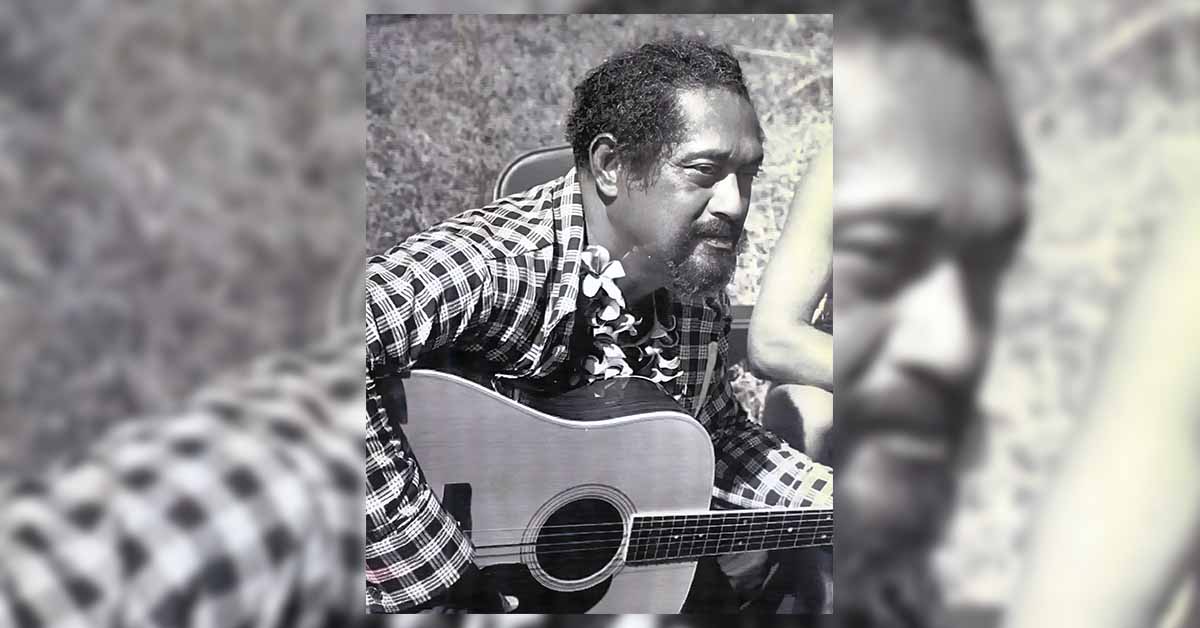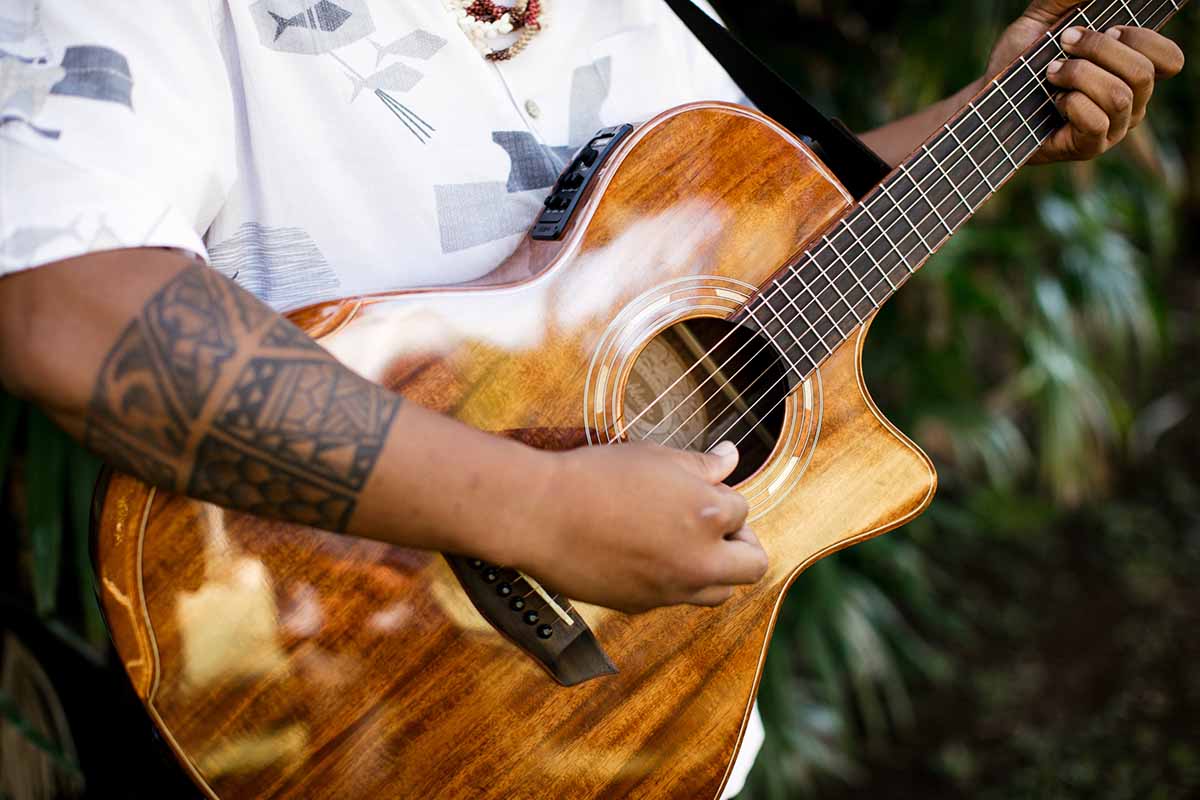
Photo: Gabby “Pops” Pahinui
While you read, listen to a great slack key album by Palm Records in Waimea.
When the vaqueros came to Hawaiʻi Island to help control the wild pīpī, they brought their music along. Up in the cool hills of Waimea, the Spanish and Hawaiian crews would gather around the fire pau hana and share stories and songs. And, when these first paniolo returned home, they left some of their guitars with the Hawaiian cowboys, and soon a new kind of music was born: kī hōʻalu (slack key).*
Keola Beamer says, “the vaqueros probably played their guitars, often two together, with one playing lead melody and the other bass and chords… At first, there possibly weren’t a lot of guitars, or people who knew how to play, so the Hawaiians developed a way to get a full sound on one guitar by picking the bass and rhythm chords on the lower three or four pitched strings with the thumb, while playing the melody or improvised melodic fills on the upper two or three pitched strings.”
There are several other theories as to how slack key came about. One theory says that as the gut strings (inevitably) broke, and before new ones could be made or obtained, the guitarist had to compensate, re-tuning the remaining five strings to make melodious chords. Another says the Spanish didn’t teach the island cowboys how to tune their instruments, although that is highly doubtful. Hawaiians were quick learners and great innovators, and music was an important part of their culture. More likely, they easily embraced the guitar, and improvised new ways to play it, for a uniquely Hawaiian sound.
However it began, slack key was then and remains today, a vastly creative, fun, and ingenious way to make music—one that can be difficult to define. We know slack key when we hear it, but what exactly makes kī hōʻalu kī hōʻalu?

Makana
Makana puts it this way, “Different cultures have ‘Slack Key.’ It’s a colloquial phrase that basically means playing in open tunings. The strings are usually tuned down, or ‘slacked,’ but they can also go up. It is a way of tuning (or slacking) the strings to a chord so the player doesn’t have to use a whole hand just to hold a chord. This frees up the fretting hand for movement while the picking hand establishes an alternating bass pattern over which a faux rhythm and lead melody are played. Essentially, it is the art of simulating multiple instruments simultaneously on a single guitar. It’s like having a mini-symphony at one’s fingertips. (Listen to Makana’s TedX Maui talk.)
Slack key is for stringed instruments, most often guitar but technically it could be played on ‘ukulele, lap steel or upright bass, for example. And, the tuning is generally adjusted, making it different from the standard six-string tuning of EADGBE.
Keola explains it this way. “The guitar was often tuned to a major chord, like the popular G Major “Taro Patch” tuning (D-G-D-G-B-D), or tunings containing a major 7th note (called ‘Wahine’ tunings), or tunings with the top two pitches tuned a wide fifth interval apart (called ‘Mauna Loa’), and other combinations. The many ingenious tunings the Hawaiians invented fall into five basic categories: Major, Wahine, Mauna Loa, Niʻihau/Old Mauna Loa, and miscellaneous.”

Photo from Hawai’i Tourism Authority
A booklet by Dancing Cat Records on George Winston’s website describes hundreds of different tunings and variations. But in addition to tuning, the booklet says style is an important element of slack key, and lists four different styles.
“The first style is playing deeply, profoundly, and simply, staying with the melody and a few ornaments, usually in a slow tempo, most evident in the older playing styles, such as that of the late Auntie Alice Namakelua (1892-1987). This also applies to the Hawaiian deep Blues style… {including} the ultimate Hawaiian blues song, ‘Kaulana Na Pua,’ written by Ellen Prendergast in 1893 after the overthrow of Queen Liliʻuokalani.
“The second style is a Slack Key jazz style, with lots of improvisation, used prominently in the music of Leland ‘Atta’ Isaacs (1929-1983)…
“The third style creates unique sounds, using ornaments like the hammer-on (or the addon), the pull-off, and harmonics (‘chimes,’ or ‘bells’)…
“The fourth Slack Key style is sometimes more entertainment-oriented, and features unusual visual and sound techniques, sometimes for entertaining the listeners, and sometimes to achieve new sounds for expression. These include: sliding up the strings with the forearm, and also playing with a bag over the fretting hand (as performed by the late Fred Punahoa and his nephew Led Kaʻapana); and the intriguing needle and thread technique, where the player dangles a needle hanging from a thread held between their teeth across the strings while otherwise playing normally with both hands.”
There is one musician whose name has become synonymous with Hawaiian slack key. In 1921, Charles Kapono Kahahawai Jr. was born into a poor family in Honolulu, and hanai’d to relatives Philip and Emily Pahinui in Kaka‘ako. He took the name Philip Pahinui, and helped the family by shining shoes, selling newspapers, and diving for coins at the harbor.*
He loved music, and somehow taught himself to play the bass fiddle at age 10. Soon after, his hanai mom bought him a $5 guitar, and he was jamming with Hawaiian musicians by age 12, and soon started gigging in clubs as a backup guitarist. A few years later, he was playing music with the Hawaiian Serenaders, and great musicians of the day, like Mahi Beamer, Sonny Chillingsworth, Eddie Kamae, Don Ho, Kui Lee, and many others. In 1946, Gabby made Hiʻilawe, the first kī hōʻalu tune ever recorded. Still, he supported his family working on the road crew for City and County of Honolulu, and later drove a trash truck.
According to gabbypahinui.com, “Although widespread acclaim eluded Gabby Pahinui till late in his life. It was in the 1970’s that he was ‘discovered’ when the album called brown ‘Gabby’ was released. Other albums followed. Gabby became a figurehead, an icon, a pied piper not to his generation but to his childrens’. He paved the way for many musicians to come. He became known as ‘Pops.’
“While playing a round of golf with friends, Charles Philip ‘Gabby Pops’ Pahinui, a Hawaiian Legend, passed away from a massive stroke at 2:27pm on October 13, 1980 and the age of 59. His music lives on.”
Kī hōʻalu, like Gabby, came from humble beginnings. It was the music of the working man, who—in their spare time and with whatever materials they had—found creative ways to make the sound their own. Today’s slack key musicians are acknowledged as masterful guitarists and award-winning songwriters who perform around the world.
When the very first Grammy Award for Hawaiian music was presented, it was presented to an album of kī hōʻalu, “Slack Key Guitar Volume 2” produced by Charles Michael Brotman. Charles has since produced two more Grammy-nominated albums, working from his Palm Records studio in Waimea, where it all began.
*Hōʻalu means loose or slack, and ki is key, as in musical key, or to tune as in tuning up the guitars, so that they are all in tune. A kī hōʻalu then, is literally a loose key, one made by slackening the guitar strings to lower their pitch. It can also refer to a key that is “loose,” or improvised, not bound by convention.
** (Son Cyril says that’s where the nickname came from. When he was diving, his curly hair became slicked back, like gabardine, so he was Gabby from then on.)
References:
- www.gabbypahinui.com
- Dancing Cat Records Hawaiian Slack Key Information Booklet, SECTION I: A BRIEF HISTORY OF HAWAIIAN SLACK KEY GUITAR (KI HOʻALU), www.GeorgeWinston.com
- https://kbeamer.com/a-brief-history-of-slack-key-guitar/
- www.Makanamusic.com/slackkey
